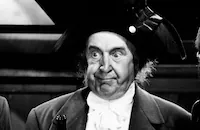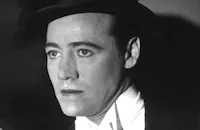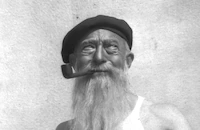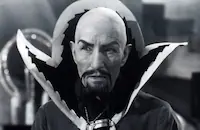The Hatchet Man

Brief Synopsis
Cast & Crew
William A. Wellman
Edward G. Robinson
Loretta Young
Dudley Digges
Leslie Fenton
Edmund Breese
Film Details
Technical Specs

Synopsis
In the early part of the twentieth century, Wong Low Get, the hatchet man for the Lem Sing Tong in San Francisco, is responsible for dispatching justice with the stroke of his hatchet. When a Tong war erupts, he is ordered to kill his best friend, Sun Yat Ming. Though Wong tries to refuse, he knows his duty to the Tong and goes to visit his old friend. Before he dies, Sun makes his will in favor of Wong, giving him guardianship over his six-year-old daughter Toya and pledging her in marriage to Wong when she comes of legal age. Wong rears Toya in both traditional Chinese and modern American ways. When she is a grown woman, he asks her to marry him, rather than forcing her to honor her father's will. She agrees, out of respect for her father's wishes, and because Wong has been so kind to her. Soon after their marriage, another Tong war breaks out. Wong, now a successful businessman, calls for negotiation, but, as a precaution, Nog Hong Fah, the head of the Lem Sing Tong, hires some young Chinese gangsters from New York to act as bodyguards. One of Wong's bodyguards is Harry En Hai, a young man close to Toya's age who she had briefly met at a dance hall before her marriage to Wong. While Wong is in Sacramento killing "Big Jim" Malone, the white gangster who started the war, Harry and Toya go dancing together and fall in love. When Wong returns, he finds them in each other's arms and plans to kill Harry. Because he had vowed to Sun always to make Toya happy and she says that Harry will make her happy, Wong goes against tradition and lets them go after making Harry promise before Buddha to keep the same vow. Nog, who has observed Wong's actions, reports them to the Tong, and Wong is ostracized by his fellow Chinese. Soon his business fails, and he is forced to become a field worker. Some years later, Wah Li, Toya's old nurse, brings Wong a letter from China from Toya. In the letter, Toya says that she has been enduring a living death and begs his forgiveness, and also says that she has always loved him. After working his way to China shoveling coal on a steamship, Wong learns the location of the opium den where she is held prisoner after Harry sold her to the owner, Madame Si-Si, to pay his debts. When Wong and Toya are reunited, he is challenged for her by Madame Si-Si, but he tells her that ancient Chinese law commands that a wife belongs to her husband. When he reveals that he is a hatchet man, she does not believe him. Wong then throws one of his weapons at a dragon painting on the wall to demonstrate his hereditary skill, and does not realize that he has inadvertently hit Harry, who is sitting behind the wall. Free from their past, Toya and Wong leave to resume their marriage. When Madame Si-Si goes to berate Harry for the loss of Toya, he blankly nods his head, then falls dead, as the hatchet, which her servant has been removing from the wall, is revealed to have lethally struck Harry in the skull.

Director

William A. Wellman
Cast

Edward G. Robinson

Loretta Young

Dudley Digges

Leslie Fenton

Edmund Breese

Tully Marshall

J. Carroll Naish

Charles Middleton

E. Allyn Warren
Eddie Piel
Noel Madison
Blanche Frederici
Otto Yamaoka
Evelyn Selbie
Willie Fung
Anna Chang
Toshia Mori
Gladys Lloyd

Ralph Ince
Crew

Videos
Movie Clip



Trailer
Film Details
Technical Specs

Articles
The Hatchet Man - The Hatchet Man
The film springs from the notoriety of the Tong wars. Tongs were associations that formed among the newly arrived immigrants of America’s Chinatown. As with other such organizations that claimed to protect immigrants, the Tongs became criminal in nature. Everyone in Chinatown had to pay fees to the Tong association, which provided “protection.” Their enforcers were the “boo how doy” or, as they became known in the English-language press, the hatchet men. Their blades filed to razor sharpness, the hatchet men left their death-dealing instruments in the skulls of anyone who crossed the Tong. In the 1870’s and 1880’s rival gangs of hatchet men would go after one another in the streets, events that became known through widespread newspaper coverage as “Tong wars.”
In a way, putting Edward G. Robinson in a film about hatchet men makes sense. Warner Brothers had purchased the David Belasco – Achmed Abdullah play The Honorable Mr. Wong about the Tong wars. Tongs were like the Chinese version of gangsters, right? So who else to put in the lead but Warner Brothers’ leading gangster star, famous for his portrayal of Little Caesar (1931)?
The story has Robinson as Wong Low Get, the most highly respected hatchet man of his Tong. Having sworn total allegiance, he cannot turn down an order, even one to kill his best friend Sun Yat Sen (J. Carroll Naish). His friend forgives him in advance of his execution, begging only that Wong raise his daughter Toya San (Loretta Young) as his own. Wong does as he has sworn but as she grows up he falls in love with her. She marries him out of a sense of obligation but a handsome gangster, Harry En Hai (Leslie Fenton) gets her to leave Wong, disgracing him and leading to a shocking turn of events.
As was typical of the time, almost no Asian actors appear in the cast of a film set completely among Chinese characters. Makeup artists had noticed that audiences were more likely to reject Western actors in Asian disguise if the faces of actual Asians were in near proximity. Rather than cast the film with all Asian actors, which would have then meant no star names to attract American audiences, studios simply eliminated most of the Asian actors from the cast.
William A. Wellman (The Public Enemy, 1931, The Ox-Bow Incident, 1943) was then directing six films a year for Warner Brothers and brought both a polish and speed to his movies, making them superior entertainments for their time. Made during the few years before strict enforcement of the Hollywood Production Code, The Hatchet Man has elements that would not be allowed later such as adultery, narcotics and a somewhat graphic use of a flying hatchet.
Director: William A. Wellman
Screenplay: J. Grubb Alexander, play by Achmed Abdullah and David Belasco
Cinematography: Sidney Hickox
Film Editing: Owen Marks
Art Direction: Anton Grot
Music: Bernhard Kaun
Cast: Edward G. Robinson (Wong Low Get), Loretta Young (Sun Toya San), Dudley Digges (Nog Hong Fah), Leslie Fenton (Harry En Hai), Edmund Breese (Yu Chang), Tully Marshall (Long Sen Yat), J. Carrol Naish (Sun Yat Ming).
BW-74m.
by Brian Cady

The Hatchet Man - The Hatchet Man
Quotes
Trivia
Notes
Motion Picture Herald incorrectly credits Nat Pendleton with the role of "Big Jim" Malone. Some contemporary reviews incorrectly call J. Carroll Naish's character "Sun Yat Sen," the name of the actual Chinese revolutionary hero who died in 1926. In the film, Naish's character's name is both written and spoken as "Sun Yat Ming". Modern sources add James Leong to the cast. The film was released in Britain as The Honourable Mr. Wong.















